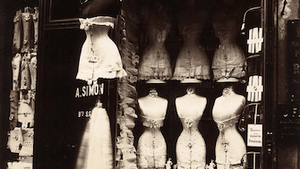Stay in the Loop
BSR publishes on a weekly schedule, with an email newsletter every Wednesday and Thursday morning. There’s no paywall, and subscribing is always free.
La Vie, l'amour in French photographic masterworks
The Barnes Foundation presents Live and Life Will Give You Pictures (first review)

In its first-ever photography exhibition, Live and Life Will Give You Pictures: Masterworks of French Photography, 1890-1950, the Barnes Foundation is presenting seminal works by a remarkable group of artists who lived and worked in and around Paris in the late 19th and early 20th centuries. Paris was, of course, a hotbed of artistic ferment and experimentation in those days, with such giants as Picasso and Matisse rubbing shoulders and artistically cross-pollinating with new photographic artists such as Man Ray, Ilse Bing and Brassaï.
A new art form
This exhibition is both a marvelous artistic display and an intensely fascinating historical document of an art form in its feisty adolescence. Broken down into eight sections (or foci, as it were) the show documents: Paris and Environs, Street Life, Commerce, Labor, Leisure, Reportage, Celebrity, and finally, Art for Art’s Sake. Each section is dominated primarily (though not exclusively) by a photographer whose work is most pertinent to its theme.
For instance, Paris and Environs features Eugène Atget. Atget wanted to document every detail of a Paris that was rapidly vanishing, being transformed and rebuilt from a medieval fortress city of 500,000 residents at the start of the 19th century to the modern City of Lights. By 1870, Paris had a population in excess of 2 million.
Casual visitors might be most interested in the Celebrity section, featuring portraits by Man Ray and Henri Cartier-Bresson of such intellectual and artistic luminaries as Picasso, Matisse, Sartre, Camus, Simone de Beauvoir and Jean Cocteau.
The late 19th and early 20th century was also a period of great political movement, and the featured photographers’s politics influenced their work. This is most evident in the Labor section, of course, where romanticization and glorification of the common laborer revealed the artists’s Marxist leanings.
The Barnes connection
In keeping with the Barnes’s core mission, information is provided in each section that explains how the photographs (or the photographers themselves) relate thematically or historically to works featured in the Barnes Collection.
At the press preview I attended, our guide was Michael Mattis, from whose personal collection the exhibition was drawn, and by Thom Collins, executive director and president of the Barnes Foundation. Fortunately, for regular patrons, the Barnes will also schedule daily guided tours of the show. Schedules for these guided tours are listed on the Barnes website.
Quite apart from their artistic merit (which is considerable), or their historical relevance (which is undeniable), the 170-plus photographs themselves are endlessly interesting. The pictures of the daily lives of ordinary people in the Street Life, Labor and Leisure sections are invaluable documentations of what life was like for Parisians a hundred years ago. They are also a testament to the fact that people don’t change that much, really, from century to century.
There is pathos and pain, love and anger, struggle, joy, beauty and death in these images. Maybe that’s why photography put down such deep roots in human culture so quickly. The camera sees all, and sees with a clarity that was irresistible — and still is.
For Stacia Friedman's review of this show, click here.
What, When, Where
Live and Life Will Give You Pictures: Masterworks of French Photography, 1890-1950. Through Jan. 9, 2017 at the Barnes Foundation, 2025 Benjamin Franklin Parkway, Philadelphia. (215) 278-7000 or barnesfoundation.org.
Sign up for our newsletter
All of the week's new articles, all in one place. Sign up for the free weekly BSR newsletters, and don't miss a conversation.

 Gary L. Day
Gary L. Day